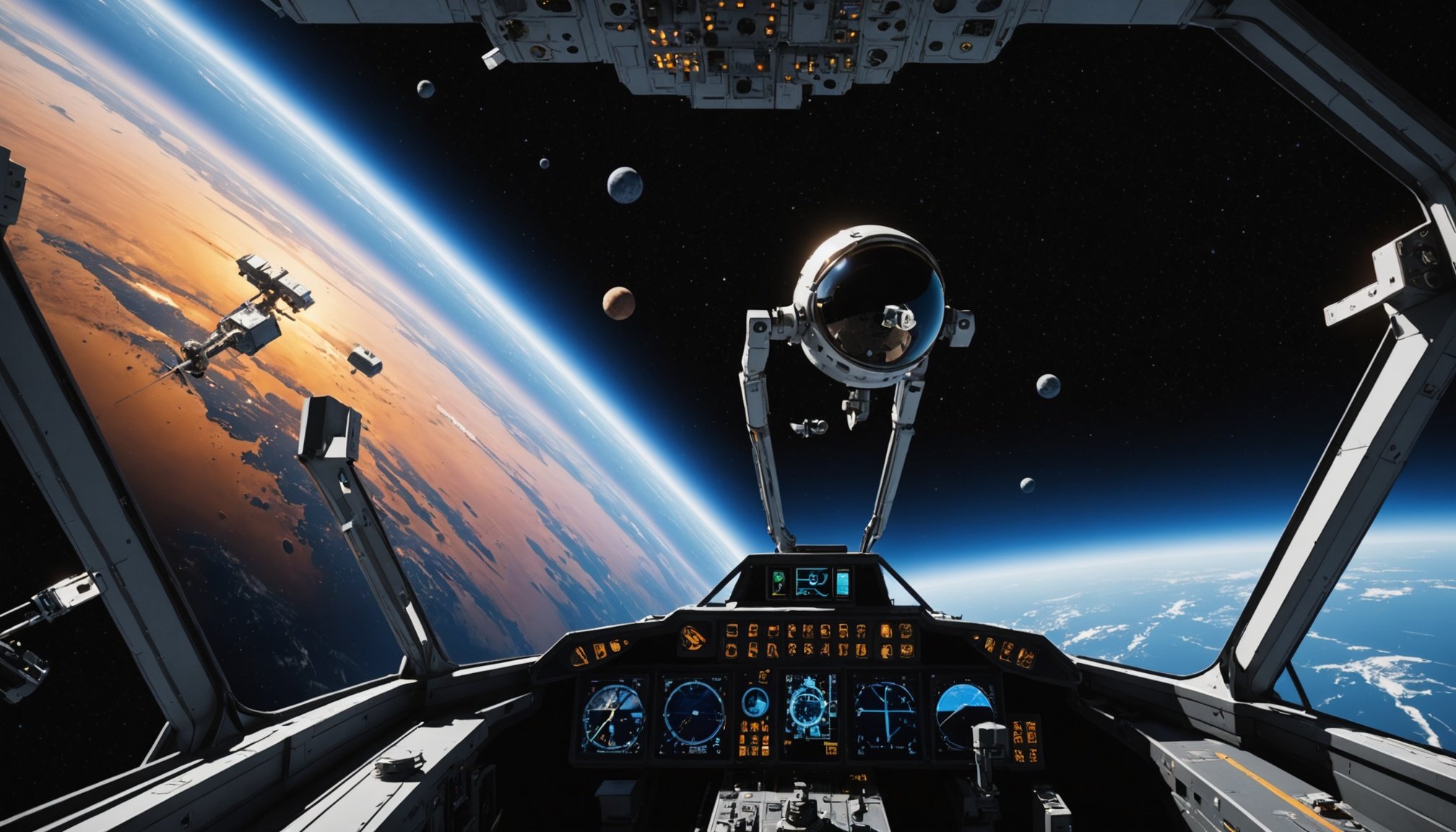Understanding the Importance of Authentic Physics in Space Simulation Games
In space simulation games, the incorporation of authentic physics plays a crucial role in crafting an immersive and engaging experience. Realism is a cornerstone that separates ordinary games from those that captivate players’ imaginations. When players encounter physics that accurately mirrors real-world principles, their engagement is heightened as actions have predictable, logical results. This meticulous attention to physics not only enriches gameplay but also elevates the educational value these games offer.
For players, simulating the complexities of space, such as gravitational pull, momentum, and orbital mechanics, allows for a deeper understanding of astrophysics concepts. This can be particularly beneficial for learners, as these experiences provide a practical context to theoretical knowledge, making learning both interactive and enjoyable.
In the same genre : Revving up realism: how real-time ray tracing transforms reflections in racing games
Furthermore, achieving authentic physics in space simulations presents unique challenges in game development. Developers must balance computational limitations with the desire for precision, often requiring innovative solutions and extensive technical expertise. These challenges, when addressed successfully, enhance overall player engagement and satisfaction. The realism not only attracts a dedicated audience but also encourages players to invest more time exploring the nuances of the game.
Common Technical Challenges in Game Development
Creating video games involves numerous technical challenges, particularly when dealing with complex physics engines and performance optimization. Game developers strive to integrate advanced physics engines into their game frameworks seamlessly. This integration demands precise calculations to simulate real-world dynamics, like object motions or interactions, making the in-game environment believable and engaging.
Also to discover : Harnessing machine learning magic: crafting lifelike npc animations for an engaging open-world gaming experience
A delicate balance between realism and performance must be maintained. How does one achieve this? By optimizing resource usage while ensuring the game remains fluid and responsive. Games can suffer from reduced frame rates and lag if the physics engine is too demanding for the available hardware. Therefore, developers must carefully manage and streamline their code to enhance performance without sacrificing the thrilling realism of the gameplay experience.
Another significant hurdle is addressing computational limitations in real-time simulations. What techniques help overcome this? Developers often rely on simplified models or approximation techniques, which reduce the computational load. Even with advanced hardware, the necessity for real-time processing means that developers must continuously push boundaries to achieve new standards of speed and accuracy. These methods ensure that games remain responsive and immersive, providing players with a seamless and enjoyable experience, despite the inherent constraints of modern computing power.
Strategies for Incorporating Authentic Physics
The integration of authentic physics within a game’s development strategy can significantly enhance the player’s experience. Successful implementations often stem from innovative development strategies and seamless gameplay integration.
Physics Modeling Techniques
Effective physics modeling is pivotal in creating a believable game environment. Developers often employ techniques like rigid body dynamics, fluid mechanics, and collision detection to bring a sense of realism. These methods allow for nuanced interactions, such as objects falling naturally due to gravity or fluids behaving realistically as they flow through different environments. Incorporating these techniques skillfully can turn a flat experience into an engaging one.
Modular Approach to Game Design
Adopting a modular approach facilitates the integration of authentic physics by enabling developers to focus on individual components before integrating them into the larger system. This approach allows for flexible adjustments and iterative improvements, ensuring that each element works harmoniously within the game’s physics engine. Modules can be tested independently and then combined, ensuring seamless gameplay integration and making future updates more manageable.
Using Real-World Data in Game Development
Leveraging real-world data is another powerful method. Collaborations with physicists and experts, along with existing research and simulations, provide a solid foundation for incorporating realistic physics. Detailed examples can be seen in games where accurate vehicle dynamics are modeled, using data from actual vehicles to simulate lifelike responses. This practice not only enriches gameplay but also builds authenticity, drawing players deeper into the virtual world.
Balancing Realism and Gameplay
Achieving gameplay balance involves a complex interplay between realism and playability. The first step in maintaining this balance is determining the appropriate level of difficulty through physics. Realistic physics can enhance immersion but may inadvertently increase complexity. It’s essential to find a middle ground where physics realism contributes positively to the player’s experience without detracting from playability.
Consider a racing game with realistic car handling. While it mirrors real-world driving, overly complex handling can overwhelm new players. Thus, mechanics should be tuned to align closely with player expectations, ensuring both challenge and accessibility. This involves leveraging engaging mechanics that provide an enjoyable, skill-level-appropriate experience.
Ensuring mechanics align with what players anticipate can bridge reality and fun. For instance, in a shooting game, players expect realistic bullet trajectories but may not desire realistic reloading times. Balancing these aspects ensures the game remains engaging without frustrating them.
Ultimately, tuning realism and consistently evaluating player feedback is key. Consider how mechanics contribute to a dynamic experience, ensuring they** maintain fun and engaging** moments. This balance fosters a rewarding environment, encouraging players to immerse themselves fully in the game.
Educational Benefits of Authentic Physics in Gameplay
Integrating authentic physics into gameplay offers significant educational value, providing players with a unique way to gain real-world knowledge. This approach intertwines entertainment with education, allowing players to better understand physical laws and concepts through experiential learning. For example, when a game replicates realistic gravity or motion mechanics, players gain a deeper appreciation and understanding of how these forces work in real life, enhancing their knowledge while engaged in play.
These games also foster learning opportunities that extend beyond traditional education. By navigating complex scenarios, players naturally develop critical thinking and problem-solving abilities. They learn to predict outcomes, make informed decisions, and adapt strategies based on real-world physics principles, thereby refining these essential skills in a dynamic, engaging environment.
Several successful case studies demonstrate the educational impact of such games. Titles that simulate space exploration or sustainable energy management, for example, have achieved notable success in educating players about environmental challenges and technological advancements. This evidence underscores how games not only entertain but also enrich player knowledge—transforming leisure activities into powerful learning experiences.
Through the clever incorporation of scientific principles, educational games offer a creative platform that inspires curiosity, equips players with practical knowledge, and cultivates lifelong skills.
Pitfalls to Avoid in Integrating Physics
Integrating physics into game development can lead to several common pitfalls. One prevalent mistake is over-complicating mechanics, which often results in player frustration. When mechanics become too complex, they can overshadow gameplay, making it difficult for players to engage or master the game. To avoid these issues, developers should focus on simplicity and ensure that gameplay remains intuitive and user-friendly.
Another common development mistake is prioritising realism over user experience. While realistic physics can enhance a game’s immersion, it should not come at the cost of playability. If a game’s realism leads to cumbersome or frustrating experiences, it can detract from the player’s enjoyment. The balance between realism and user experience is crucial to retain player engagement.
To mitigate these common pitfalls, developers should implement effective strategies. Conducting user testing is vital—feedback from players can highlight frustrating or confusing elements. Additionally, creating clear design goals helps maintain focus on both realism and gameplay. By iterating based on real player input and adhering to initial design objectives, developers can create a balanced and engaging game experience, avoiding the pitfalls of over-complication and poor user experience.
Interviews and Case Studies from Developers
In the realm of space simulation games, developer insights offer a treasure trove of understanding. These insights not only highlight industry experiences but also shape the future trajectory of such games.
Successful Developer Interviews
One key to uncovering the success behind popular space simulation games lies in the valuable developer insights shared during interviews. Developers reveal the creative processes and technological innovations employed, providing a rare glimpse into the behind-the-scenes dynamics. These conversations often reflect on the industry experiences that influenced their final output, molding both the game mechanics and the storytelling aspects.
Lessons Learned from Leading Games
Case studies of prominent titles depict a wealth of knowledge. By examining these, developers and enthusiasts alike can identify best practices. Industry experiences shared in these case studies often illustrate the importance of balancing realism with engaging gameplay. Lessons on optimizing physics engines and narrative integration are recurrent themes.
Future Trends in Space Simulation Games
As the industry evolves, developer insights predict upcoming trends. The simulation of more complex physics within expansive game universes signals a transformative direction. Insights gathered from real-world industry experiences suggest a continuous push towards more immersive, detailed environments. Innovators anticipate leveraging advances in artificial intelligence and virtual reality to redefine player experiences, heralding a new era in space simulation gaming.










